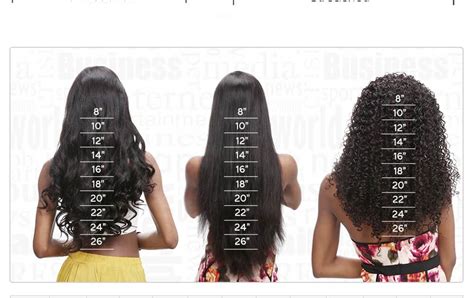Why Measure Hair Length?
Measuring hair length is crucial for various reasons:

- Hairstyle planning: Determine the appropriate length for your desired hairstyle.
- Hair care routine: Monitor hair growth and adjust hair care regimen accordingly.
- Tracking progress: Quantify the effectiveness of hair treatments or hair growth supplements.
- Haircut appointments: Communicate your desired length to your hairstylist accurately.
- Wig or hairpiece fitting: Ensure proper fit and style selection.
How to Use the Hair Inch Chart
The hair inch chart is a simple grid that corresponds hair length in inches with visual representations for reference. To use it:
- Wet your hair and comb it straight.
- Start measuring from the scalp, holding the ruler or measuring tape vertically.
- Extend the measuring tool down to the desired point on the hair shaft.
- Record the measurement in inches.
Hair Inch Chart
| Hair Length (inches) | Visual Representation |
|---|---|
| 1 | Just below the ears |
| 2 | Shoulder length |
| 3 | Collarbone length |
| 4 | Mid-length, above the elbows |
| 5 | Elbow length |
| 6 | Forearm length |
| 7 | Wrist length |
| 8 | Shoulder-skimming |
| 9 | Mid-back length |
| 10 | Lower back length |
| 11 | Waist length |
| 12 | Hip length |
| 13 | Thigh length |
| 14 | Knee length |
| 15 | Calf length |
| 16 | Ankle length |
Common Hair Length Terms
- Short: Generally refers to hair that falls above the shoulders, typically 1-3 inches in length.
- Medium: Hair that extends from the shoulders to the elbows, ranging from 4-7 inches in length.
- Long: Hair that reaches beyond the elbows and can vary from 8 inches to several feet in length.
- Extralong: Hair that exceeds 15 inches in length.
Factors Affecting Hair Growth
Hair growth rate varies from person to person and is influenced by several factors:
- Genetics: Predetermines the maximum hair growth potential.
- Age: Growth rate slows down with age, especially after 50.
- Nutrition: A balanced diet rich in vitamins and minerals supports hair growth.
- Lifestyle: Stress, sleep patterns, and hormonal imbalances can impact hair growth.
- Hair care practices: Excessive heat styling, chemical treatments, and tight hairstyles can damage hair and hinder growth.
Tips for Healthy Hair Growth
- Maintain a healthy diet and lifestyle.
- Reduce stress and get adequate sleep.
- Use gentle hair care products and avoid over-processing.
- Protect hair from damage by using heat protectant and avoiding tight hairstyles.
- Trim split ends regularly to promote healthy hair growth.
Conclusion
Measuring hair length with a hair inch chart provides a clear understanding of your current hair length and helps you set realistic growth goals. By monitoring hair growth and making adjustments to your hair care routine, you can achieve healthy, beautiful hair at any length.
